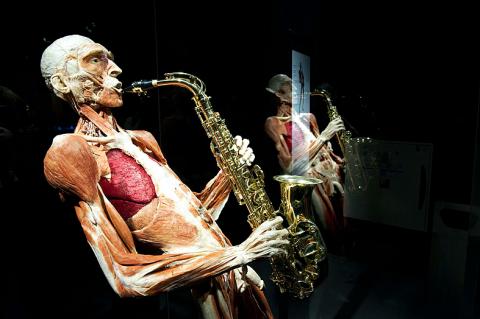Seven years after its Taiwan debut, anatomical exhibition Body Worlds returns with a new exhibition titled Body Worlds & The Cycle of Life (人體奧妙之生命巡迴展), which comprises more than 200 preserved human and animal specimens. The 2004 exhibition aimed to educate the public about the beauty and fragility of the body, while The Cycle of Life focuses on the process of aging.
On display at the National Taiwan Science Education Center (台灣科學教育館) in Taipei’s Shilin District (士林) until Sept. 25, the exhibition of human “plastinates” begins with fetal development and includes detailed introductions to all the organ systems, including specimens with deformities.
Body Worlds was originally developed by German anatomist Gunther von Hagens, who in 1977 invented what he calls the plastination preservation technique, which involves replacing the specimen’s water and fat with reactive polymers such as silicone rubber. The Body Worlds Web site (www.bodyworlds.com) says it takes about one year to plastinate a human body.

Photo: EPA
Body Worlds & the Cycle of Life is open to viewers of all ages, but some may find viewing an exhibition that includes a splayed human head distasteful.
■ Until Sept. 25 at National Taiwan Science Education Center (台灣科學教育館), 189 Shishang Rd, Taipei City (台北市士商路189號)
■ Monday to Friday from 9am to 5pm, weekends and public holidays from 9am to 6pm
■ Admission is NT$280 for adults, NT$250 and NT$140 for concessions. Tickets are available online (www.walkieticket.com) and at the door. Audio guide players in English and Mandarin are available for NT$100
■ On the Web: www.bodyworlds.com.tw

May 26 to June 1 When the Qing Dynasty first took control over many parts of Taiwan in 1684, it roughly continued the Kingdom of Tungning’s administrative borders (see below), setting up one prefecture and three counties. The actual area of control covered today’s Chiayi, Tainan and Kaohsiung. The administrative center was in Taiwan Prefecture, in today’s Tainan. But as Han settlement expanded and due to rebellions and other international incidents, the administrative units became more complex. By the time Taiwan became a province of the Qing in 1887, there were three prefectures, eleven counties, three subprefectures and one directly-administered prefecture, with

It’s an enormous dome of colorful glass, something between the Sistine Chapel and a Marc Chagall fresco. And yet, it’s just a subway station. Formosa Boulevard is the heart of Kaohsiung’s mass transit system. In metro terms, it’s modest: the only transfer station in a network with just two lines. But it’s a landmark nonetheless: a civic space that serves as much more than a point of transit. On a hot Sunday, the corridors and vast halls are filled with a market selling everything from second-hand clothes to toys and house decorations. It’s just one of the many events the station hosts,

Among Thailand’s Chinese Nationalist Party (KMT) villages, a certain rivalry exists between Arunothai, the largest of these villages, and Mae Salong, which is currently the most prosperous. Historically, the rivalry stems from a split in KMT military factions in the early 1960s, which divided command and opium territories after Chiang Kai-shek (蔣介石) cut off open support in 1961 due to international pressure (see part two, “The KMT opium lords of the Golden Triangle,” on May 20). But today this rivalry manifests as a different kind of split, with Arunothai leading a pro-China faction and Mae Salong staunchly aligned to Taiwan.

Two moves show Taichung Mayor Lu Shiow-yen (盧秀燕) is gunning for Chinese Nationalist Party (KMT) party chair and the 2028 presidential election. Technically, these are not yet “officially” official, but by the rules of Taiwan politics, she is now on the dance floor. Earlier this month Lu confirmed in an interview in Japan’s Nikkei that she was considering running for KMT chair. This is not new news, but according to reports from her camp she previously was still considering the case for and against running. By choosing a respected, international news outlet, she declared it to the world. While the outside world